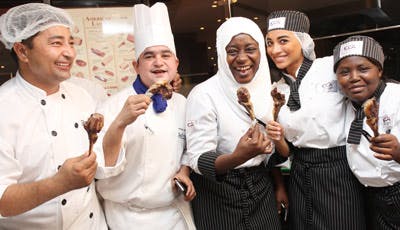Middle East U.S. Lamb Chef Training Workshops

Chef Uwe Micheel (second from left) presents a certificate of completion to a UAE chef as Alaa Kamal of Midamar and Eliane Elia, USMEF Middle East representative, look on
One of the fastest growing economic regions of the Middle East, the United Arab Emirates (UAE) has a large expatriate community among its 7.5 million population as well as booming tourism. Both audiences have a strong interest in lamb and mutton, and recent workshops for chefs in the UAE on U.S. lamb already are generating positive results.
More than 65 chefs from leading regional hotels as well as restaurant and culinary institute personnel participated in two training programs conducted by the U.S. Meat Export Federation (USMEF) and the American Lamb Board in collaboration with the Office of Agricultural Affairs (OAA) U.S. Consulate General, Dubai and the Emirates Culinary Guild (ECG).
The two workshops were led by distinguished executive chefs: Uwe Micheel, president of the Emirates Culinary Guild and director of Kitchens at Radisson Blu Hotel in Dubai, and Peter de Kauwe, executive chef at The Club in Abu Dhabi. Alaa Kamal, Midamar’s Middle East regional director for U.S. lamb exports and the supplier of the U.S. lamb cuts, also attended the workshops.
The participating chefs were introduced to high quality U.S. lamb cuts and a variety of cooking applications. During the educational segment of the workshop, USMEF representatives provided information on U.S. lamb production practices, available cuts, culinary versatility and lamb’s nutritional profile to UAE chefs and purchasing managers.

UAE chefs sample U.S. lamb
At a hands-on session, participants were asked to prepare creative and innovative recipe ideas using a range of U.S. lamb cuts including the rack, leg and shoulder. Chefs created entrees such as lamb loin medallions with red pepper salsa, lamb tagine and lamb tartar with sun-dried tomato bread.
“The demand for red meat in the Middle East is rising, and lamb is traditionally a basic component in many local dishes,” said Bassam Bousaleh, USMEF representative in the UAE. “Being a hub for trade, business and tourism, there is growing demand in the region for high-quality food. Consequently, we see lamb imports rising, with exciting opportunities in the foodservice sector.”
The response from the participating chefs has been extremely positive.
“Your products are very good, and I will recommend them in my hotel,” said Mohammed Hassanain of the Dubai Marine Beach Resort. Of the participating chefs, 80 percent said they would like to introduce U.S. lamb dishes on their menus.
“The Middle East currently is the No. 4 market for U.S. lamb and mutton exports, and through the first four months of 2014, it is the brightest spot for exports,” said Megan Wortman, executive director of the American Lamb Board. “Sales to the region this year are up 31 percent in volume and 26 percent in value, and programs like this will help to further enhance awareness and appreciation for the quality and value of U.S. lamb and mutton products.”
U.S. lamb and mutton sales to the entire Middle East region last year rose 346 percent in volume and were valued at about $1 million. Early indications from the recent lamb programs indicate that additional orders from the targeted chefs will be forthcoming.
“We see great potential for growth in this region,” said John Brook, USMEF regional director for Europe, Russia and the Middle East.
“There are currently more than 93,000 hotels in the region, with 71 percent of them being four or five-star hotels,” said Brook. “Another 28,000 hotel rooms are scheduled to be built in the next two years, meaning that demand for high-quality menu items, like U.S. lamb, will be growing as well.”
